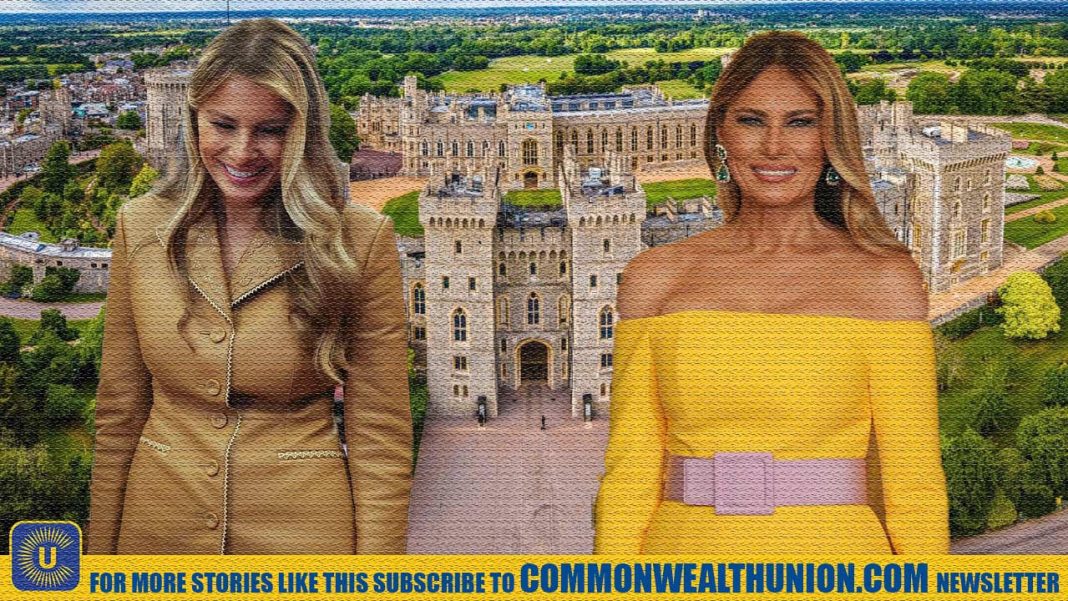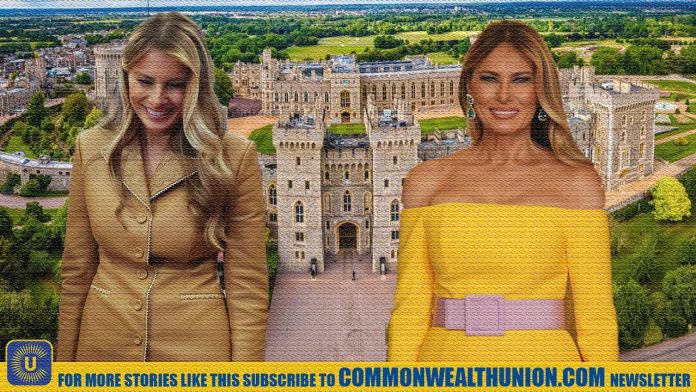Melania Trump’s appearance at the State Banquet at Windsor Castle on 17 September 2025 will long be remembered—not because she broke protocol, but because she mastered the art of visual ambiguity. Her ensemble was, initially, inscrutable: from certain angles and under particular lighting, it seemed bold yet composed; in others, it looked like something else entirely. But once you looked closely at the belt, at the shade, at the interplay of colour, the details spoke volumes.
The First Lady stepped into St George’s Hall in a dazzling off‑the‑shoulder Carolina Herrera gown in canary yellow (or buttercream yellow, depending on your source). The fabric hugged her form, the neckline emphasised her shoulders, and a very deliberate slit introduced a touch of daring elegance. What held the look together and also stirred conversation was the wide belt cinching her waist. Was it soft lilac? Baby pink? Violet? The debate erupted almost instantly.
Fashion analysts and insiders eventually offered clarity: the gown is most accurately described as buttercream yellow, and the belt is “Easter purple”, a lilac‑leaning purple. But due to flash photography, saturation differences and ambient lighting, many photos made the belt look pink, while others made it appear closer to lilac.
Why did such differences matter so much? This was not solely a matter of colour. It was about control, intention, and the power of subtle drama. On the surface, Melania’s outfit seemed restrained—yellow is vibrant, yes, but scissors‑clean in its styling, free of heavy adornment. Yet the belt, small in scale compared to the sweeping gown, became the focal point of a million conversations. It was a symbol of how details shift perception. Her elegance was paradoxically both certain and mutable.
In a way, she was inscrutable until she allowed the light and the camera and the viewer to do part of her styling for her. The discrepancy between the actual and perceived appearances mirrored previous instances of colour illusion on the internet, such as the blue/black versus the white/gold dress from 2015.
Critics were divided. Some praised her for making a statement, for embracing risk, for breaking away from her more usual neutral, structured, sometimes austere silhouettes. They saw the yellow‑and‑purple (or pink‑looking) pairing as bold, sunny, and optimistic—perhaps a nod to joy, or at least visibility. Others felt the look was mismatched: that the belt clashed, that the yellow was too loud for the formal gravity of a royal banquet, and that the off‑shoulder cut risked propriety in such an event.
Yet the fact that opinions diverged is part of what makes this her Look of the Week. A fashion moment isn’t always about universal acclaim—it’s often about dialogue, about what a garment can provoke in light, in camera flash, and in public perception. In that sense, Melania’s inscrutability was a feature, not a bug.
The belt itself, then, was not simply an accessory—it was a pivot. It turned an otherwise straightforward statement into a puzzle. With its texture, finish, width, and colour, it created movement in a still image and ambiguity in what should have been certainty. “Easter purple” was the insider’s term, but if you saw pink, you weren’t wrong—just seeing a different face of the same thing. Lighting, camera settings, and human perception all conspired to cloud and clarify in turn.
In a time when people scrutinise public figures meticulously, Melania Trump demonstrated that style retains its element of mystery. Her dress at Windsor Castle did not just show up—it let viewers show up too, decoding, interpreting, and arguing. And sometimes fashion’s greatest power lies in that moment when it stops being just about what you wear and becomes about what you and I see.
A belt, a colour, and a thousand opinions — Melania Trump turned a simple accessory into a global fashion mystery. Whether it was pink, purple, or somewhere in between, she reminded us that true style doesn’t just dress to impress — it dresses to intrigue.







